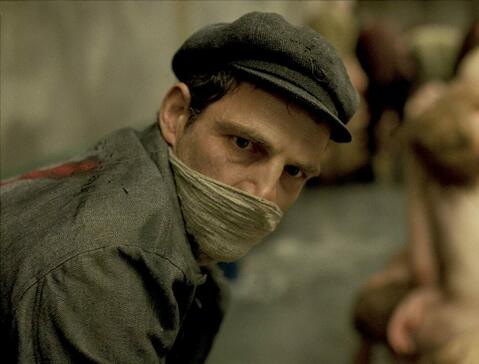SON OF SAUL
****
Director: László Nemes
Screenwriters: László Nemes and Clara Royer
Principal cast:
Géza Röhrig
Levente Molnár
Urs Rechn
Jerzy Walczak
Country: Hungary
Classification: M
Runtime: 107 mins.
Australian release date: 26 February 2016
Previewed at: Sony Pictures Theatrette, Sydney, on 17 February 2016
Set in the infamous Auschwitz-Birkenau Nazi death camp in 1944, Son Of Saul, the debut feature of Hungarian director László Nemes, is without doubt the most realistic portrayal of the machinery and manpower it took to organise and operate industrial scale murder that you are ever likely to see.
Little wonder that the camps left an indelible mark on all those who witnessed the horror and lived to tell the tale. Nemes has condensed the story into the space of a couple of days and it is seen through the eyes of a Hungarian Jew, Saul Ausländer (Géza Röhrig), working in a Sonderkommando unit that operated in the camp. These units were composed of Jews who were forced, under threat of their own deaths, to aid in the killing and disposal of gas chamber victims. So that they could maintain their physical strength, which was necessary for them to be able to dispose of the mass of bodies, the Germans allowed the selected workers more food and cigarettes and they were also allotted their own barracks, separate from the other detainees.
Prisoners arrived at the camp throughout the day and night and were stripped naked and sent to the gas chambers en-masse almost immediately, bewildered and with no time to grasp what was actually happening. This was because it all happened at a very fast pace, with loud speakers urging everyone on with, chillingly, the promise of hot soup after the ‘showers.’ Naturally the Nazis didn’t want news to reach the outside world so they would gas the members of the Sonderkommando units within three or four months. Of course the workers were not given any notice of this but, in the meantime, they had to herd the victims in, drag their bodies from the gas chambers, incinerate them and then shovel their ashes into the nearby river, in the full knowledge that this was to be their fate too. Sometimes they would come across members of their own families in the piles of corpses left after the gas had done its work.
In an opening shot which takes a number of minutes, a man walks into focus in full close-up. Mátyás Erdély’s hand-held 35 mm. camera becomes this man’s, Saul’s, point of view, following him as he goes about his daily tasks but never straying beyond his own field of vision, hearing, and presence. It acts like a voyeur as people enter and leave the frame, constantly moving, rarely pausing, like The West Wing on steroids. It is cold and uncompromising when we view what is happening in this inferno as Saul, unblinking and emotionless, observes the chaos around him.
But then something happens to stir Saul from his torpor - he witnesses the murder of a young boy by an SS doctor and becomes obsessed with finding a rabbi to deliver the Kaddish and giving the boy a proper burial. The child may be his son, or he may be a symbol of all the murdered innocents but, regardless, he goes to incredible lengths to provide the child with a decent burial. Questions have to be asked - did Saul even have religion prior to this part of his existence? Is he like the biblical Saul, undergoing a type of conversion on his own road to Damascus? It’s interesting to reflect that Saul’s surname, Ausländer, means foreigner or alien. Has Saul always been an outsider, even in his own life, until this point? Nemes leaves the audience to seek its own truth in the midst of this hellish confusion.
Son Of Saul has already garnered a number of awards and is Hungary’s selection for Best Foreign Language Film in this year’s Oscars, an award it is likely to win. Although it is a thoroughly distressing film, and probably the most graphic dealing with this time in history when a nation appeared to have gone mad, it doesn’t tell the story of the Holocaust, just the simple story of one man caught in a horrifying situation. It is important that films like this are made to confront us and remind us… lest we forget.
